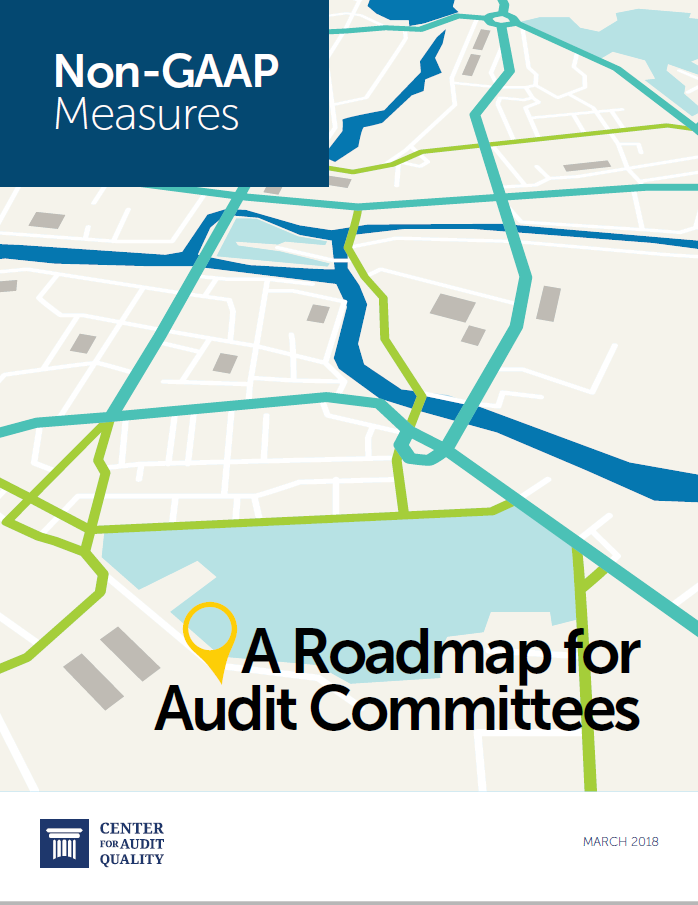Non-GAAP Measures – A Roadmap for Audit Committees
 Non-GAAP measures, while providing additional insight into the operations, financial position and liquidity of a company, also remain an area of focus for regulators. A new tool issued by the Center for Audit Quality examines key themes emerging from a series of recent stakeholder discussions which paved the way for creation of a Non-GAAP roadmap for audit committees to follow in their oversight of the financial reporting process.
Non-GAAP measures, while providing additional insight into the operations, financial position and liquidity of a company, also remain an area of focus for regulators. A new tool issued by the Center for Audit Quality examines key themes emerging from a series of recent stakeholder discussions which paved the way for creation of a Non-GAAP roadmap for audit committees to follow in their oversight of the financial reporting process.
Overview
In March 2018, the Center for Audit Quality (CAQ) released a new tool Non-GAAP Measures – A Roadmap for Audit Committees, as a culmination of their recent series of stakeholder roundtables designed to solicit discussions around the usefulness and challenges of using Non-GAAP financial measures and to identify opportunities to enhance public trust and confidence in such measures.
The use of non-GAAP measures, particularly in certain industries, has increased in popularity for a variety of reasons including demand from analysts and the need by management to better tell a company’s story about how it evaluates company performance and compensates employees on that performance. Issues arise around the use of these types of measurements when they are not calculated consistently from period to period or comparable to measures disclosed by other companies. Another area of concern that has emerged is that such measures are often not subject to the same financial accounting and reporting control rigors of information prepared under U.S. GAAP.
The presentation and use of both non-GAAP and Key Performance Indicators (KPIs) has been a key focus of the SEC over the years. The SEC staff has issued specific guidance on the presentation of non-GAAP disclosures, made it the topic of several speeches, and continues to issue comment letters to companies where they believe the company has gone astray of reporting requirements. Companies have become more alert to and wary of demonstrating reporting behaviors that indicate “cherry picking” and/or “earnings management” in the eyes of the SEC.
Key Themes Identified from the CAQ Roundtables
The CAQ has been highly focused in this area and held three industry roundtables – focused on pharmaceutical, real estate and technology – that included audit committee members, management, investors, securities lawyers, accountants and auditors. The following discussion themes emerged:
-
Why companies present non-GAAP measures.
-
Why GAAP is a baseline.
-
Challenges related to non-GAAP measures – consistency issues, significant time spent discussing, analyzing, preparing, comparing to peer groups, and use in determining incentive compensation for employees.
-
Whether standardization of such measures is limiting to the company and increased transparency is perhaps more desirable.
-
Importance of non-GAAP as a communication tool of overall company strategy.
-
Addressing good judgment through dialogue between the audit committee, management, and the auditors around policies and controls.
-
Vital role of audit committee oversight – management participants wholly recognized the importance of audit committee oversight and involvement with non-GAAP measures.
The Roadmap
From here, the CAQ crafted a “roadmap” based on the identification of several key discussion topics for the audit committee to follow in ensuring the non-GAAP measures provide a balanced presentation of company performance. Components of this roadmap include:
-
Engaging with investors.
-
Examining management’s consideration of policies, controls, and benchmarking practices.
-
Understanding the perspectives of counsel and the external auditor on the company’s use of non-GAAP measures and what procedures may be performed by the external auditor to increase the company’s confidence in its non-GAAP measures.
-
Adoption of leading practices related to disclosure controls, policies, and voluntary audit committee disclosures.
The CAQ concluded that “…non-GAAP measures that are presented in compliance with the applicable SEC rules and that are transparent, calculated consistently, and comparable across companies can help investors and other users understand a company’s results of operations, financial position, or liquidity. Greater awareness and discussion of non-GAAP measures by audit committees will contribute to high quality reporting that meets the needs of its users.” There remains no “one-size-fits-all” approach but continuing audit committee oversight and dialogue with stakeholders can help set expectations regarding roles and responsibilities, increase auditor engagement and help improve overall understanding in this area.
Next Steps
This new Roadmap is the third in a series of recent non-GAAP tools issued by the CAQ which further includes Questions on Non-GAAP Measures: A Tool for Audit Committees and Non-GAAP Financial Measures: Continuing the Conversation. Such tools have been designed by the CAQ with significant input from stakeholders and serve as valuable resources to audit committees in the execution of their oversight duties and increasing transparency, consistency and reliability within the financial reporting chain.
BDO has recently reported on Non-GAAP measures in our year-end Audit Committee Round Up: Focal Points, Tools & Resources for use by audit committees and management. We applaud the CAQ for continuing to produce valuable tools and resources on this topic and will continue to highlight these and other activities, trends, and relevant discussion points to our client audit committees and management teams through our Center for Corporate Governance and Financial Reporting.
SHARE